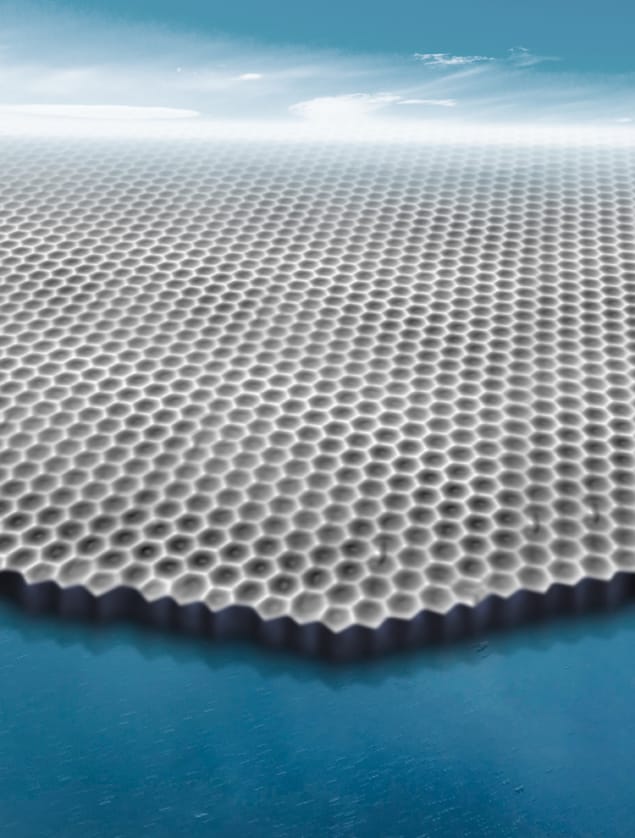
It’s well known that water vapour in the air can transform directly into solid ice on cold days, forming a thin layer on surfaces such as windowpanes or windshields. This commonplace process is, however, little understood, and a team of researchers in China and the US has found a new way it can happen. Using a non-contact atomic force microscopy technique combined with theoretical calculations, the team studied how ice grows in two dimensions on a surface. Their findings could prove useful in designing materials from which ice can be removed more readily, and their technique might also be extended to other 2D materials – especially those with multiple metastable and intermediate edge structures.
Low-dimensional water exists when water is confined at the interface between two solid surfaces. It is ubiquitous in nature and plays a critical role in many fields, including materials science, chemistry, biology and atmospheric science. Knowing its structure is thus very important.
2D bilayer hexagonal ice
In their work, the researchers, led by Ying Jiang and Enge Wang of Peking University, in collaboration with Xiao Cheng Zeng of the University of Nebraska-Lincoln, imaged a 2.5 Å-thick layer of 2D bilayer hexagonal ice (which corresponds to two water layers) that they had grown on a hydrophobic Au(111) surface at a temperature of around 120 K. The non-contact atomic force microscopy (AFM) technique they employed is based on a “qPlus” sensor that uses a mechanical tip functionalized with a carbon monoxide molecule.
Thanks to the ultrahigh flexibility of the tip apex and the weak nature of high-order electrostatic forces between the tip and the ice, the tip interacts only weakly with the water sample. This limits the damage to fragile structures that form at the edge of the ice, and enables the researchers to obtain images of unstable intermediate edge structures in which the H and O atoms of the water are distinguishable. To extend the imaging time, they cooled the samples down to 5 K once ice growth had stopped, freezing them before imaging them with AFM. In this way, they were able to reconstruct ice growth processes with atomic precision.
Zigzags and armchairs
Hexagonal ice is the main type of naturally-occurring ice on Earth, and this arrangement of water molecules is the reason why all snowflakes have six-fold symmetry. The basal plane of this form of ice has a structure that is very similar to 2D ice, and it can terminate in two types of edges, known as “zigzag” and “armchair”. Zigzag edges usually predominate, while armchairs are normally absent because of the higher density of unsaturated hydrogen bonds, which increases the energy of these edges, thus reducing their stability.
In the current work, the researchers found that armchair edges can in fact become stable when ice grows in two dimensions. What is more, the growth of these edges follows a hitherto unseen reaction pathway in which five- and seven-membered rings of water molecules are present in an intermediate stage of ice growth. This result, which Zeng’s team confirmed in computer simulations, is quite different to the six-membered rings previously observed in zigzag growth patterns.
2D ice I
The result confirms the existence of the first genuine 2D ice, which the researchers have dubbed 2D ice I. It also opens the door to explore other 2D ice phases in nature, Jiang tells Physics World. This 2D bilayer hexagonal ice was first predicted to exist in 1997, but a direct image of its atomic structure, which has a fully saturated H-bonding structure, was lacking until now. The way it grows may completely change our conventional understanding of low-dimensional ices and may guide designers of anti-icing and superlubricative materials in the future, Jiang says.

Ice-water interface goes viscous
Ice removal is critical for structures such as wind turbines, which cannot function when they are covered in ice. Understanding the interaction between this water ice and surface will help us develop new materials to make this ice removal easier, he adds. Jiang also suggests that the group’s technique could be extended to study the growth mechanisms of other 2D materials, opening up a new avenue for visualizing the structure and dynamics of low-dimensional matter.
The researchers, who report their work in Nature, are now busy studying how 2D ice evolves to 3D, which has a wider relevance to ice formation and growth in general. “We expect that the 2D growth mode can persist up to a certain thickness, after which the ice layer will undergo a structural transformation from a stacked flat bilayer conformation to an interconnected buckled bilayer one – similar to how graphite changes into diamond,” Jiang says.



